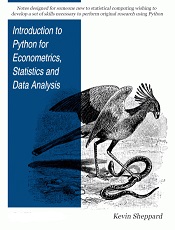
|
FreeComputerBooks.com
Links to Free Computer, Mathematics, Technical Books all over the World
|
|
- Title Introduction to Python for Econometrics, Statistics and Data Analysis
- Author(s) Kevin Sheppard
- Publisher: KevinSheppard.com (September 2021.)
- Paperback N/A
- eBook: PDF (407 pages)
- Language: English
- ISBN-10: N/A
- ISBN-13: N/A
- Share This:

|
Python is a popular general purpose programming language which is well suited to a wide range of problems. Recent developments have extended Python's range of applicability to econometrics, statistics and general numerical analysis. Python – with the right set of add-ons – is comparable to domain-specific languages such as R, MATLAB or Julia.
This book provides an introduction to Python for a beginning programmer. They may also be useful for an experienced Python programmer interested in using NumPy, SciPy, and matplotlib for numerical and statistical analaysis. They should also be useful for students, researchers or practitioners who require a versatile platform for econometrics, statistics or general numerical analysis (e.g. numeric solutions to economic models or model simulation).
About the Authors- N/A
- Python Programming
- Data Analysis and Data Mining, Big Data
- Financial Mathematics, Mathematical Economics, and Financial Engineering
- Statistics, Mathematical Statistics, and SAS Programming
- Probability and Stochastic

- Introduction to Python for Econometrics, Statistics and Data Analysis (Kevin Sheppard)
- The Mirror Site (1) - PDF
-
 Using Python for Introductory Econometrics (Florian Heiss, et al.)
Using Python for Introductory Econometrics (Florian Heiss, et al.)
This book introduces the popular, powerful and free programming language and software package Python, focuses on implementation of standard tools and methods used in econometrics.
-
 Python Programming for Economics and Finance
Python Programming for Economics and Finance
Looking to enhance your skills in Economics and Finance? Dive into Python programming! With libraries like Pandas, NumPy, and Matplotlib, you can analyze data, build models, and visualize trends like never before.
-
 Python for Everybody: Exploring Data in Python 3
Python for Everybody: Exploring Data in Python 3
This book is designed to introduce students to programming and software development through the lens of exploring data. You can think of the Python programming language as your tool to solve data problems that are beyond the capability of a spreadsheet.
-
 O'Reilly® Think Python, 2nd Edition (Allen B. Downey)
O'Reilly® Think Python, 2nd Edition (Allen B. Downey)
This hands-on guide takes you through the Python programming language a step at a time, beginning with basic programming concepts before moving on to functions, recursion, data structures, and object-oriented design. 2nd edition updated for Python 3.
-
 From Python to NumPy (Nicolas P. Rougier)
From Python to NumPy (Nicolas P. Rougier)
NumPy is one of the most important scientific computing libraries available for Python. This book teaches you how to achieve expert level competency to perform complex operations, with in-depth coverage of advanced concepts.
-
 Guide to NumPy (Travis E. Oliphant)
Guide to NumPy (Travis E. Oliphant)
This book is for programmers, scientists, or engineers, who have basic Python knowledge and would like to be able to do numerical computations with Python. It will give you a solid foundation in NumPy arrays and universal functions.
-
 NumPy Tutorials (Usman Malik, Anne Bonner, et al)
NumPy Tutorials (Usman Malik, Anne Bonner, et al)
They provide everything you need to know to get started with NumPy. They also explain the basics of NumPy such as its architecture and environment, discusses the various array functions, types of indexing, etc. With examples for better understanding.
-
 Scipy Lecture Notes (Emmanuelle Gouillart, et al)
Scipy Lecture Notes (Emmanuelle Gouillart, et al)
This book is the teaching material on the scientific Python ecosystem, a quick introduction to central tools and techniques. It is for programmers from beginner to expert. Work on real-world problems with SciPy, NumPy, Pandas, scikit-image, and other Python libraries.
-
 SciPy Programming Succinctly (James McCaffrey)
SciPy Programming Succinctly (James McCaffrey)
This book offers readers a quick, thorough grounding in knowledge of the Python open source extension SciPy. The SciPy library, accompanied by its interdependent NumPy, offers Python programmers advanced functions that work with arrays and matrices.
-
 Python Data Science Handbook: Essential Tools (Jake VanderPlas)
Python Data Science Handbook: Essential Tools (Jake VanderPlas)
Several resources exist for individual pieces of this data science stack, but only with the Python Data Science Handbook do you get them all - IPython, NumPy, Pandas, Matplotlib, Scikit-Learn, and other related tools.
-
 Basic Data Analysis and More - A Guided Tour Using Python
Basic Data Analysis and More - A Guided Tour Using Python
In this book, a selection of frequently required statistical tools will be introduced and illustrated. From a point of view of data analysis, an exemplary implementation of the presented techniques using the Python programming language is provided.
-
 Mining Social Media using Python: Finding Stories in Data
Mining Social Media using Python: Finding Stories in Data
This book shows you how to use Python and key data analysis tools to find the stories buried in social media. Perform advanced data analysis using Python, Jupyter Notebooks, and the pandas library.
-
 Python Scripting for Spatial Data Processing (Pete Bunting, et al)
Python Scripting for Spatial Data Processing (Pete Bunting, et al)
This book is a Python tutorial for beginners aiming at teaching spatial data processing. It is used as part of the courses taught in Remote Sensing and GIS, using psycopg2, and ogr2ogr, etc., at Aberystwyth University, UK.
-
 Python for Geospatial Analysis (Ujaval Gandhi)
Python for Geospatial Analysis (Ujaval Gandhi)
Suitable for GIS practitioners with no programming background or python knowledge. The course will introduce basic Python programming concepts, libraries for spatial analysis, geospatial APIs and techniques for building spatial data processing pipelines.





